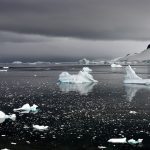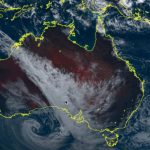 August 18, 2021 11:39 am
Published by Jenny Rislund
August 18, 2021 11:39 am
Published by Jenny Rislund
In this project you will be addressing the challenge of recurring droughts by helping us build a collection of data visualisations to tell the story of Victoria’s parched history. Your collection will help us understand these droughts were experienced by people across the state, and how our understanding of drought is changing as we move into a warmer world.
 August 18, 2021 11:27 am
Published by Jenny Rislund
August 18, 2021 11:27 am
Published by Jenny Rislund
The jet stream is a band of strong westerly winds in the upper atmosphere. Shifts in the jet are associated with shifts in the storm tracks, with associated changes in regional weather and rainfall. This project will look at methods to characterise the position and strength of the jet stream in the Southern Hemisphere, with a focus on changes in the Australian region with time.
 August 18, 2021 11:26 am
Published by Jenny Rislund
August 18, 2021 11:26 am
Published by Jenny Rislund
Ozone depletion over Antarctica from the late 1970s to 2000 has been linked to changes in the surface climate over the Southern Hemisphere in summer, among them a more positive Southern Annular Mode (SAM). Over Australian latitudes, a more positive SAM is associated with increased rainfall over eastern Australia in the summer season. Given stratospheric ozone over Antarctica is projected to recover to 1980 levels by ~2050, the impact of ozone recovery on its own would be to reduce this upward trend in summertime rainfall over eastern Australia.
 August 18, 2021 9:29 am
Published by Jenny Rislund
August 18, 2021 9:29 am
Published by Jenny Rislund
Dimethyl sulfide (DMS) is a biogenic source of sulfate aerosol that influences the climate system by reducing solar radiation and altering cloud properties. Recent observations suggest that DMS may play a dominant role in the aerosol and cloud formation along the Antarctic coast where DMS is produced by marine microbes that reside on top, in, and under sea ice. However, the role of DMS remains unclear especially over the regional scale, partly due to the lack of compilation of DMS data.
 August 18, 2021 9:13 am
Published by Jenny Rislund
August 18, 2021 9:13 am
Published by Jenny Rislund
This project aims to quantify the disproportionate exposure to urban heat intensity across major Australian cities. Urban heat stress poses a major risk to the health and wellbeing of urban dwellers. Case studies of individual cities suggest that environmental stressors such as urban heat may be unequally distributed across income groups.
 August 18, 2021 9:12 am
Published by Jenny Rislund
August 18, 2021 9:12 am
Published by Jenny Rislund
The student will work with climate model output from Earth System Models participating in the sixth round of the Coupled Model Intercomparison Project (CMIP6) to assess how a gradual decrease in atmospheric carbon dioxide impacts carbon uptake and storage in the global ocean. Together with a partner project this project will test the reversibility of carbon emissions in terms of the marine system.
 August 17, 2021 11:43 am
Published by Climate Extremes
August 17, 2021 11:43 am
Published by Climate Extremes
The modelling program has now settled in with weekly MOM/COSIMA meetings while working with other research programs on projects that will continue to improve our models and the way we use them in our research. This work has extended to industry and peer network stakeholders.
 August 17, 2021 11:30 am
Published by Climate Extremes
August 17, 2021 11:30 am
Published by Climate Extremes
The Attribution and Risk program is taking shape with regular meetings on the fourth Wednesday of every month and has established focused questions and research around the processes that shape Australian extremes and the advanced machine learning/statistical approaches that will help produce the answers.
 August 17, 2021 10:38 am
Published by Climate Extremes
August 17, 2021 10:38 am
Published by Climate Extremes
The ocean’s much larger heat capacity acts as “memory” suppressing the atmosphere’s “high-frequency variability” (over time scales of weeks) while producing oceanic motions that vary over longer time scales. This paradigm aims to explain how low-frequency variability emerges in the ocean. But, recently, this paradigm has been challenged.
 August 15, 2021 12:16 pm
Published by Climate Extremes
August 15, 2021 12:16 pm
Published by Climate Extremes
An interesting conversation at Kim Reid’s first AMOS Conference led not only to a new PhD topic but also to her taking part in an international collaborative research project.










